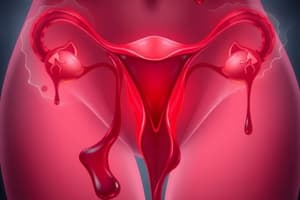Podcast
Questions and Answers
What is the WHO classification for primary amenorrhea?
What is the WHO classification for primary amenorrhea?
- Never menstruated at 15 years old (correct)
- Menstruation starting after the age of 12
- Menstruation not occurring within 5 years of breast development
- Delayed menstruation beyond 18 years old
What is Type 1 primary amenorrhea based on?
What is Type 1 primary amenorrhea based on?
- Menstruation not occurring within 3 years of breast development
- Delayed menstruation beyond 18 years old
- Menstruation starting after the age of 12
- Menstruation not occurring within 5 years of breast development (correct)
When does secondary amenorrhea occur?
When does secondary amenorrhea occur?
- After experiencing regular menstrual periods (correct)
- After menstruating for at least 6 months
- After never menstruating in one's life
- After the age of 15
What is the main difference between primary and secondary amenorrhea?
What is the main difference between primary and secondary amenorrhea?
What defines Type 1 primary amenorrhea?
What defines Type 1 primary amenorrhea?
What is the age criteria for primary amenorrhea according to WHO classification?
What is the age criteria for primary amenorrhea according to WHO classification?
In Type 1 primary amenorrhea, what is the key milestone that has not been reached?
In Type 1 primary amenorrhea, what is the key milestone that has not been reached?
What is the main distinguishing factor between primary and secondary amenorrhea?
What is the main distinguishing factor between primary and secondary amenorrhea?
Which axis plays a key role in regulating the menstrual cycle and is mentioned in the text?
Which axis plays a key role in regulating the menstrual cycle and is mentioned in the text?
What is the defining characteristic of secondary amenorrhea according to the text?
What is the defining characteristic of secondary amenorrhea according to the text?
Study Notes
Amenorrhea: Definition and Classification
- Primary amenorrhea is defined as never having menstruated by 15 years old, according to the WHO classification.
- Type 1 primary amenorrhea is characterized by not menstruating within 5 years of breast development, which typically occurs at 13 years old.
Objectives
- Review menarche and the H-P-O axis (Hypothalamic-Pituitary-Ovarian axis).
- Differentiate between primary and secondary amenorrhea and their causes.
- Discuss approaches to diagnosis and management of amenorrhea.
Studying That Suits You
Use AI to generate personalized quizzes and flashcards to suit your learning preferences.
Description
This quiz covers the concepts of primary and secondary amenorrhea, including definitions, causes, diagnosis approaches, and management strategies. It also includes a review of menarche and the H-P-O axis for better understanding.




